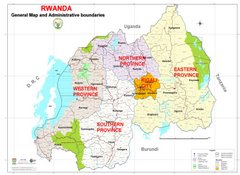Emmanuel Mungwarakarama
Nyungwe park
Date : Jan 30, 2007
An extensive network of well-maintained walking trails leads through the forest to various waterfalls and viewing points. Well-trained guides, camp sites and specific tours make Nyungwe forest a special income-generating spot.
Can Nyungwe forest welcome more tourists and therefore create more job opportunities to the neighboring locals citizens?
A uniquely rich centre of floral diversity, Nyungwe forest has at least 250 different types of trees and a myriad of flowering plants. The forest hosts 140 types of colorful orchids, 4 groups of primates: 13 species in all, including humankind’s closest living relative, the chimpanzee, blue monkeys, mangabeys, as well as black and white colobus monkeys.
“If maintaining the same prices can protect and facilitate the park conservation, it should be a way of improving this tourism industry in the country,” said Mike Macfadyen, an American environmental researcher from Alaska.
Prices are high, Macfadyen complained.
“This limits access to the forest, but it is also better for park conservation.”
It costs $10 US/1000 Rwf for locals to enter the park and $20 U$/2000 Rwf for foreigners.
Even if prices are high, the number of tourist increases year after year. In 2000, 500 people came, whereas in 2006, the number grew to 3878. Most of them come from Britain, America and Germany.
“Making a choice is so difficult as we have different trails,” said guide Edward Bahizi. “Each is different from another, and as we are taking the pink route, we will meet a waterfall, different types of trees like mahogany and you can even meet birds.”
Bahizi, a trained guide, is healthy, weighing in at 100 kilos. He looks like a young man but he is 35. He speaks 8 different languages.
Nyungwe does, however, deserve more time. Anybody who wants to track chimps and see several varieties of smaller primates will need two days there - and dedicated birdwatchers might never want to leave! Good hours to see chimps are between 6 and 9 in morning.
The Park covers more than 1000 square kilometers of rugged terrain, spanning an altitudinal range from 1600 to 1950 m.
Extending across the majestic hills of southeast Rwanda, Nyungwe National Park is the largest forest in East or Central Africa with 1030 Km2.
Nyungwe’s overall biological diversity has earned it a place on many lists of priority sites for conservation in Africa.
“The uniqueness of this park, and what makes it different from other parks in the world, is here you can find the specified tour sites,” said Macfadyen Adding to this Mike showed that if there was no planned way to provide guides, the conservation would be hard.
Aside from preserving the diverse flora and fauna in Nyungwe, conservation of the forest is important for scientific and sociological reasons, too.
“A French researcher has produced medicine from the trees found in this park,” said Edward.
According to the tourism website, bamboo blankets much of the extreme south-eastern portion of the park. Flooded forests, marshes, and open herbaceous slopes are interspersed throughout. The fauna of Nyungwe reflects this floral diversity.
“Nyungwe Forest acts as the water catchment for about 70 percent of Rwanda,” said Anet Tamale, an ORTPN Public relations office staff. “As such, it protects a major watershed for surrounding communities as well as those further downstream”
People living near the forest experience longer periods of rain each year, supporting their farming activities around the forest. Streams that flow from Nyungwe feed into the Nile and Congo basins.
Tourism in Nyungwe generates some revenue for the national parks and benefits Rwanda’s economy at large.
“A percentage from the income goes to the district level so it can help in building community capacity” confirmed Anet Tamale.
Nyungwe faces several major threats, which stem from the high human pressure around the forest and the need for more land or alternative sources of income.
Friday, February 2, 2007
Subscribe to:
Post Comments (Atom)
Rwanda

Administrative map
Blog Archive
-
►
2010
(59)
- ► 09/19 - 09/26 (1)
- ► 07/11 - 07/18 (5)
- ► 07/04 - 07/11 (5)
- ► 06/27 - 07/04 (4)
- ► 06/20 - 06/27 (6)
- ► 06/06 - 06/13 (17)
- ► 05/30 - 06/06 (4)
- ► 03/28 - 04/04 (2)
- ► 02/28 - 03/07 (3)
- ► 02/21 - 02/28 (5)
- ► 01/24 - 01/31 (2)
- ► 01/17 - 01/24 (4)
- ► 01/10 - 01/17 (1)
-
►
2009
(25)
- ► 11/08 - 11/15 (9)
- ► 10/04 - 10/11 (2)
- ► 01/25 - 02/01 (2)
- ► 01/18 - 01/25 (12)
-
►
2008
(55)
- ► 12/28 - 01/04 (1)
- ► 12/21 - 12/28 (11)
- ► 12/14 - 12/21 (3)
- ► 12/07 - 12/14 (5)
- ► 11/30 - 12/07 (2)
- ► 11/16 - 11/23 (22)
- ► 11/09 - 11/16 (4)
- ► 07/13 - 07/20 (1)
- ► 06/01 - 06/08 (6)
-
▼
2007
(19)
- ► 05/20 - 05/27 (2)
- ► 04/01 - 04/08 (1)
- ► 03/04 - 03/11 (1)
- ► 02/25 - 03/04 (2)
- ► 02/18 - 02/25 (2)
- ► 02/11 - 02/18 (6)
- ► 02/04 - 02/11 (3)
-
►
2006
(59)
- ► 10/22 - 10/29 (12)
- ► 10/15 - 10/22 (1)
- ► 10/08 - 10/15 (2)
- ► 09/03 - 09/10 (2)
- ► 08/27 - 09/03 (6)
- ► 07/09 - 07/16 (7)
- ► 06/18 - 06/25 (1)
- ► 04/09 - 04/16 (5)
- ► 04/02 - 04/09 (23)
No comments:
Post a Comment